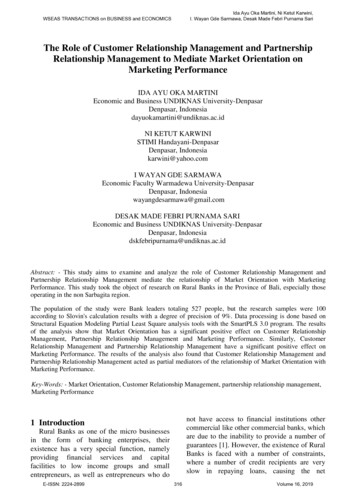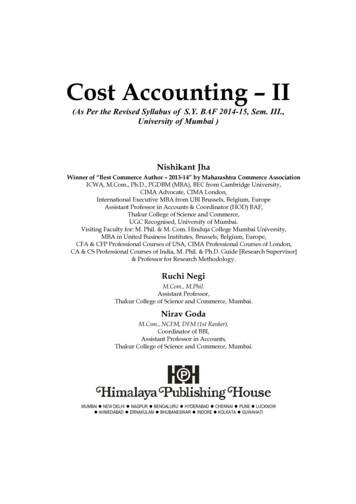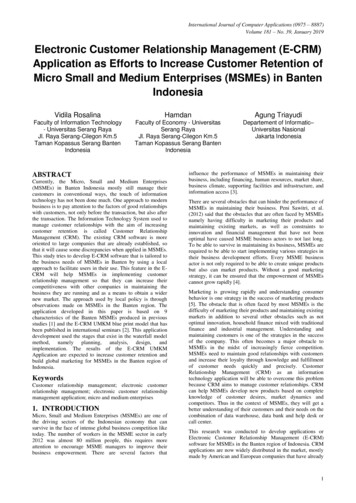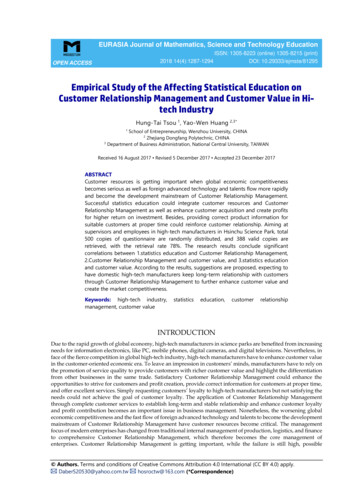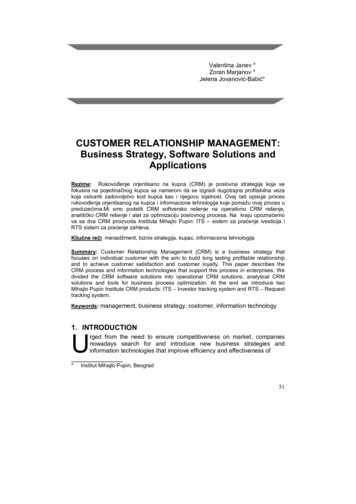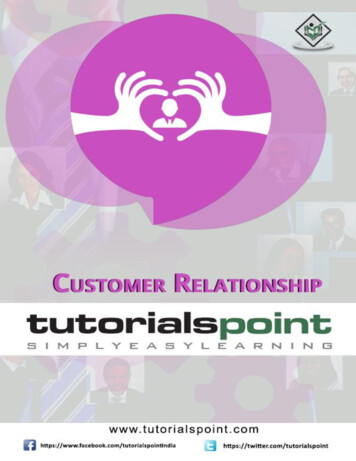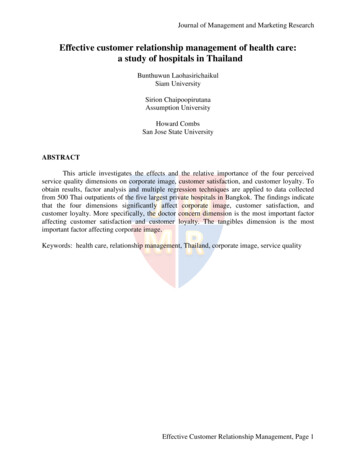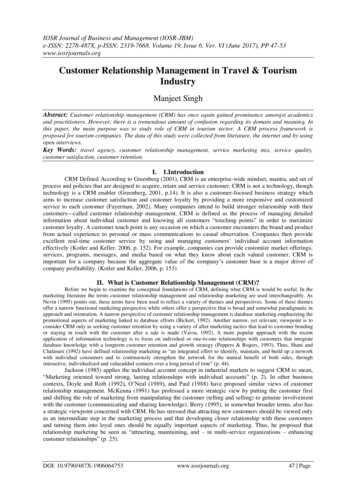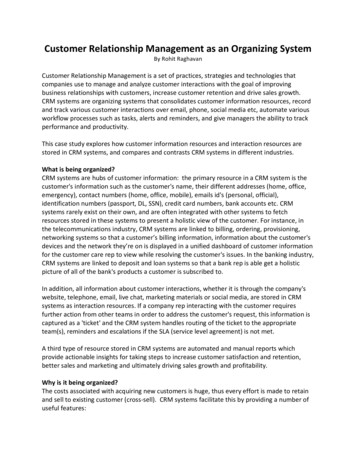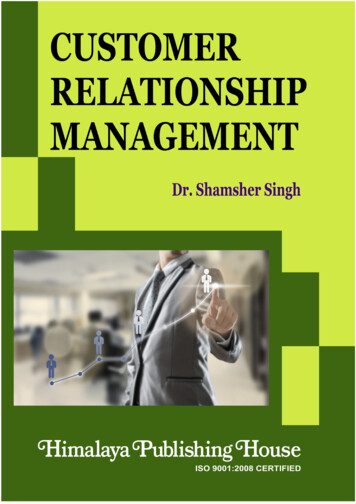
Transcription
Customer RelationshipManagementDr. Shamsher SinghProfessor and Head of Dept. – MBA,BCIPS, GGSIP University,Dwarka, New Delhi.ISO 9001:2008 CERTIFIED
AuthorNo part of this publication may be reproduced, stored in a retrieval system, or transmitted in any form or by anymeans, electronic, mechanical, photocopying, recording and/or otherwise without the prior written permission of thepublisher.First Edition : 2018Published by:Branch Offices:Mrs. Meena Pandey for Himalaya Publishing House Pvt. Ltd.,“Ramdoot”, Dr. Bhalerao Marg, Girgaon, Mumbai - 400 004.Phone: 022-23860170, 23863863; Fax: 022-23877178E-mail: himpub@vsnl.com; Website: www.himpub.comNew Delhi:“Pooja Apartments”, 4-B, Murari Lal Street, Ansari Road, Darya Ganj,New Delhi - 110 002. Phon e: 011-23270392, 23278631; Fax: 011-23256286Nagpur:Kundanlal Chandak Industrial Estate, Ghat Road, Nagpur - 440 018.Phone: 0712-2738731, 3296733; Telefax: 0712-2721216Bengaluru:Plot No. 91-33, 2nd Main Road Seshadripuram, Behind Nataraja Theatre,Bengaluru-560020. Phone: 08041138821, 09379847017, 09379847005Hyderabad:No. 3-4-184, Lingampally, Besides Raghavendra Swamy Matham, Kachiguda,Hyderabad - 500 027. Phone: 040-27560041, 27550139Chennai:New-20, Old-59, Thirumalai Pillai Road, T. Nagar, Chennai - 600 017.Mobile: 09380460419Pune:First Floor, "Laksha" Apartment, No. 527, Mehunpura, Shaniwarpeth(Near Prabhat Theatre), Pune - 411 030. Phone: 020-24496323, 24496333;Mobile: 09370579333Lucknow:House No. 731, Shekhupura Colony, Near B.D. Convent School, Aliganj,Lucknow - 226 022. Phone: 0522-4012353; Mobile: 09307501549Ahmedabad:114, “SHAIL”, 1st Floor, Opp. Madhu Sudan House, C.G. Road, Navrang Pura,Ahmedabad - 380 009. Phone: 079-26560126; Mobile: 09377088847Ernakulam:39/176 (New No. 60/251), 1st Floor, Karikkamuri Road, Ernakulam,Kochi - 682011. Phone: 0484-2378012, 2378016; Mobile: 09387122121Bhubaneswar:Plot No. 214/1342, Budheswari Colony, Behind Durga Mandap,Bhubaneswar - 751 006. Phone: 0674-2575129; Mobile: 09338746007Kolkata:108/4, Beliaghata Main Road, Near ID Hospital, Opp. SBI Bank,Kolkata - 700 010. Phone: 033-32449649; Mobile: 07439040301DTP by: SunandaPrinted at: M/s. Charita Impressions, Hyderabad. On behalf of HPH.
Preface In today’s highly competitive business world, both CRM and excellence in customerservice are strategically important. Business managers know that providing quality customerservice is essential to increase satisfaction in order to increase relationship share andsubsequently to achieve revenue growth. The main idea of CRM is to have betterunderstanding about customers so that the firm can serve them in an improved way, andthus enhance customer satisfaction. It will lead to better customer perception about firm andpositively affect relationship share.Customer Relationship Management is putting the customer at the heart of the business.With the support of technology, the organization can have a 360-degree view of the customer,which will enable them to improve the quality and satisfaction of each customer interactionand maximize the profitability of customer relationships, a win-win for both organizationand customers. CRM is a business strategy that apply to every organization. It meansworking with customers such that they receive great service and are motivated to returnagain and again to do more business with the organization. Depending on how one look at it,CRM can be practiced in companies at different levels. It can be practiced at theorganizational level (ideally). It can be practiced at a front end (customer facing level) –anything that has to do with interactions with customers, marketing, sales and service. Or itcan be practiced at the very functional level, like in a call center within a sales force, etc.CRM requires a customer-centric business philosophy and culture to support effectivemarketing, sales and service processes. CRM applications can enable effective customerrelationship management, provided that an enterprise has the right leadership, strategy andculture. Customer Relationship Management is about maximizing value with your customer.In this competitive global economy, a key business strategy is focused on infrastructure anddelivery of business processes to manage and deliver customer value across multiplechannels.Over the last two decades, a significant amount of effort has been devoted to the studyof relationship marketing, which is concerned with the activities organizations undertake inan attempt to develop and maintain successful relational exchanges with their customers.While the voluminous literature on relationship marketing has and continues to enhanceunderstanding about the characteristics, antecedents and consequences of relationalexchange, it has also generated numerous related insights which are starting to exert a stronginfluence upon current marketing research, practice and thought.The effective and efficient management of customer relationships presents a difficultchallenge for service providers, a challenge which grows in complexity as the heterogeneityin a firm’s customer base increases. That is, when providers are compelled (by marketconditions) to pursue customers who differ in terms of their needs and preferences, itbecomes significantly more difficult for them to build the right type of relationship with theright type of customer. This added difficulty arises from the inherent intricacies associated
with: (1) distinguishing between “customer types” based on their apparent needs andpreferences, and (2) having to behave differently towards each individual customer (i.e.,crafting relationship-appropriate interactions) given their particular “customer type”. As aconsequence, the quality of a provider’s customer portfolio is ultimately determined by howwell it is able to balance two conflicting organizational needs: the need to market its productsand services to a heterogeneous customer base, and the need to effectively and efficientlymanage its exchange relationship with each individual member of that customer base.On the one hand, global competition has become more intense, while on the other,opportunities for cooperation across borders have never been greater. Long-term survival ofbusinesses, and indeed entire economies, depend on how well these forces are understoodand leveraged. Students of customer relationship will be at considerably advantage in theserespects when they embark on their careers. It has become essential for business managers,policy makers and researchers involved in the global environment to understand customerrelationship. In the 21st century, goods, services and knowledge flow across country bordersmuch more easily than in the past. For business, the implications of these flows and theincreased mobility of human resources are profound and can be taken care if theyunderstand their customers.The author has undertaken the research work in the area of customer relationshipmanagement in different industries in India. There are many research papers published inrefereed international and national journals by the author. This has provided the desiredfoundation to built the strong pillars and valuable insight on the subject and writing thepresent book. There are number of the books of Indian and foreign authors available in themarket dealing with this subject, still the need was felt to write a book which covers thesyllabus of leading Indian universities and the professional courses of master degree inManagement/Business Administration. Keeping in view this fact, the attempt has beenmade to write text book which can cover the syllabus of such courses. The present book is anattempt in this direction.The author feels that the text book will be useful for all Universities in the country as thesubject is not only discussed at length but also presented with several examples and casestudies. Several questions, exercise problems and objective type questions have also beenprovided at the end of each chapter for the benefit and better understanding of students. Theauthor wishes the students, research scholars and faculty to read the book and giveinvaluable suggestions or corrections that are required for better improvement of thepresentation of the subject content, although, care has been taken to make it error-free text.The author humbly requests the readers to bear with, if any mistakes are found andintimate the author by email at shamsher 1965@rediffmail.comAuthor
Acknowledgements Writing a text book is an arduous task that requires enormous perseverance, enduranceand sustained commitment over a long period of time. It also involves incredible sacrifices ofother opportunities, social occasions, family leisure and social gathering not only for me butalso for entire family especially my wife Ms Rajkumari and children Raveena and Ravish,making this book in its real sense our book rather than my book. I would like to extend mysincere gratitude to my all family members for their continuous support and inspiration.The motivation to write the book entirely goes to my students to whom I have taughtthis subject several times. I would like to extend my sincere thanks to all of them as well as toall those students who will be my future students. The subject matter of this book has beenadopted from my research work, other books on the subject, professional journals,magazines, other publications as well as internet. However, while adopting the relevantsubject matter, the emphasis has been given on its relevance in Indian context. I thank allthose writers and researchers whose thoughts and theories have been helpful in bringing outthis book. Their contribution has been duly acknowledged. My deep gratitude and sincerethanks to all of them, without their contribution this book would not have been possible. Iam grateful to all of them.I owe a debt of gratitude to my professional colleagues for their support. A special noteof thanks is due to my publisher to Himalaya Publishing House Pvt. Ltd and their staff inextending their wholehearted support and encouragement. I would like to extend my thanksto numerous prospective readers of the book and welcome their suggestions. Last but not theleast I should thank God, for this grace and inspiration, word of thanks appear so inadequate.I eagerly look forward to receive your valuable comments, feedback and suggestion forfurther improvement of the book at shamsher 1965@rediffmail.com, for which I would behighly grateful.Author
Contents Sr. No. Chapter NamesPage No.1.Introduction: Customer Relationship Management2.CRM Applications Decisions and Myths10 - 263.The Customer Relationship ManagementFrameworks/Models27 - 364.Principles of Customer Relationship Management37 - 465.CustomerRetention47 - 646.The CRM Process65 - 747.Electronic Customer Relationship Management (eCRM)75 - 908.CRM Cycle and Customer Life Cycle9.CRM Architecture106 - 11710.Data Warehouse118 - 13111.Data Mining132 - 14512.Benefits of CRM Architecture146 - 15513.Sales Force Automation (SFA)156 - 16414.Enterprise Marketing Automation (EMA)165 - 177RelationshipBuildingandCustomer1-991 - 105
15.Call Center178 - 18816.CRM Implementation189 - 20317.Developing CRM Strategy204 - 22218.Keys to CRM Successful Implementation223 - 23619.Integration of CRM with ERP System237 - 24320.Service Quality and Its Dimensions244 - 25421.Managing Customer Communication255 - 26922.Impact of CRM on Marketing Channels and SupplyChain270 - 28523.Emerging Trends of Marketing Channels and SupplyChain Management286 - 29924.Managing Unprofitable Customer using CRMKnowledge300 - 31025.Future Developments in CRM311 - 324Case Studies325 - 440Selected References441 - 442
tINTRODUCTIONIn the fiercely competitive business operating environments,Customer Relationship Management (CRM) is emerging as acore marketing activity. On average, firms spend six times moreto acquire new customers than to keep them (Reichild, 1996).Hence, many firms devote more attention and developrelationship with customers to enhance their trust in the firm.This enhanced trust will increase the customer’s willingness toengage in a relationship with the firm and to increase customerrelationship share of that firm. Overall, this enhancedrelationship may result in maximization of customer repeatbusiness and revenue.CRM is a comprehensive approach for creating, maintainingand expanding customer relationship. The basic concept of CRMis not new to the business. The purpose of the business accordingto famous management guru Peter Drucker is to “create andkeep a customer”. The entire business process is consisting of ahighly integrated effort to discover, create, arouse and satisfycustomer needs. The modern business is realizing it, in an effortto become a “customer-centric operation” across the globe.Hence, CRM is a continuous process and progress in thedevelopment. It is a new way of doing business, covering allaspects and an integral approach of dealing with customers withthe smart use of information technology.
2 Customer Relationship ManagementThe term CRM was first used in 1993 by Tom Siebel, hence it is closely connected toSiebel System – an IT company. Therefore, many executives are under the misconceptionthat CRM is principally an IT implementation, this is the exact cause of many failures – andthere have been many of them. If technology is applied to a faulty business strategy, all thatis going to happen is that the company is going to become more efficient at doing the wrongthings. If the core business strategy isn’t put right first, there will be failure. As CRM isviewed more as a strategy than a process, organizations must get the business strategy rightfirst. Decide which customers or segments to target. Develop sensible customer acquisition,retention and development plans. Sort out the channel strategy first (direct or indirect) thensort out which products, services and bundles of value to offer to the chosen customers.Once that’s in position, then one may start looking for IT to support it – but not until then.As in a business of one sort or another, the goal of marketers is to have CRM help toacquire, grow and retain profitable customer relationships to create a sustainablecompetitive advantage. Without a doubt, customer loyalty is a key driver of profitability.Creating customer loyalty must be an integral part of your organization’s strategy –particularly in a time of industry consolidation. Understanding customers’ requirements isfundamental to business success. Reichheld’s (1996) research which demonstrated that astrong link exists between customer loyalty and corporate profitability. Customer acquisitioncosts, 5 to 7 times higher than customer retention costs (Kotler, 1997), can be held in check;while profits can be boosted by 25% to 85% by reducing customer defections by a mere 5%(Reichheld and Sasser, 1990).The following are the different types of business imperatives for a successful CRMstrategy: Creating a customer-focused organization and infrastructure.Assessing the lifetime value of the customer’s profitability.Maximizing the profitability of each individual customer.Methods to attract and retain the best customers.Establishing and maintaining long-term relationship with customers.Offering contractual safeguards like guarantees, warranties and building thecustomer confidence.The organization should impart the training programs, so as to familiarize theemployees with their role and the rationale for change. The training programsshould teach managers the ways to track, recognize and reward activities related toCRM.In today’s highly competitive business world, both CRM and excellence in customerservice are strategically important. Business managers know that providing quality customerservice is essential to increase satisfaction in order to increase relationship share andsubsequently to achieve revenue growth. The main idea of CRM is to have betterunderstanding about customers so that the firm can serve them in an improved way, andthus enhance customer satisfaction, which may lead to better customer perception about firmand positively affect relationship share.Customer Relationship Management is putting the customer at the heart of the business.With the support of technology, the organization can have a 360-degree view of the customer,
Introduction: Customer Relationship Management 3which will enable them to improve the quality and satisfaction of each customer interactionand maximize the profitability of customer relationships, a win-win for both organizationand customers. CRM is a business strategy that apply to every organization. It meansworking with customers such that they receive great service and are motivated to returnagain and again to do more business with the organization. Management Guru PeterDrucker said “The true business of every organization is to make and keep customers”.1Depending on how one look at it, CRM can be practiced in companies at different levels. Itcan be practiced at the organizational level (ideally). It can be practiced at a front end(customer facing level) – anything that has to do with interactions with customers, marketing,sales and service. Or it can be practiced at the very functional level, like in a call centerwithin a sales force, etc. While CRM requires a customer-centric business philosophy andculture to support effective marketing, sales and service processes, CRM applications canenable effective customer relationship management, provided that an enterprise has the rightleadership, strategy and culture.2 Customer Relationship Management is about maximizingvalue with your customer. In this competitive global economy, a key business strategy isfocused on infrastructure and delivery of business processes to manage and deliver customervalue across multiple channels.3DEFINITIONS OF CRMCRM has been defined as tracking customer behavior in order to develop marketing andrelationship-building programs that bond consumers to a brand often by development ofsoftware systems to provide one-to-one contact between the marketing business and theircustomer. CRM is the core of any customer-focused business strategy and includes thepeople, processes, and technology associated with sales, marketing, and service.4Various scholars have defined CRM in different ways. Some of these definition are: It is core business strategy for managing and optimizing all customer interactions(Sowalskie, 2001) which helps in learning about the needs, wants and buyingbehavior of its customers. This understanding of customer’s need/want and buyingbehavior helps the firm customize products to satisfy them. This positively effectscustomers’ satisfaction and thus potentially enhance customers’ attitude towardsthe firm, subsequently enhancing customers’ intention to accept a relationship withthe firm.Customer Relationship Management is also defined as “a comprehensive strategyand process of acquiring, retaining and partnering with selective customers tocreate superior value for the organization and the customers” (Jadish N. Seth, AtulParvatiyar and G. Shainesh, 2001).1Bob Thomson (2003), Customer think guide to real mer think guide to real CRM.2Bob Thomson (2003), Customer think guide to real er think guide to real crm.htm4
4 Customer Relationship Management G.C. Beri (1995) has defined CRM as “a process of attracting new customers,maintaining, developing close relationship and enhancing customer relationship”.According to Shani and Chalasani (1992), CRM is “an integrated effort to identify,maintain and build up a network with individual customers and to continuouslystrengthen the network for the mutual benefits of both sides, through interactive,individualize and value added contacts over a long period of time”.According to Jackson (1985), CRM mean “marketing oriented towards strong,lasting relationship with individual customers”.Gronroons (1990) states it as “marketing to establish, maintain and enhancerelationship with customers and other partners, at a profit so that objective of theparties involved are met through mutual exchange and fulfillment of promises”.Morgan and Hunt (1994) suggest it as “all marketing activities directed towardsestablishing, developing and maintaining successful relationships with thecustomers”.Zablah (2004) has defined CRM as an “ongoing process that involves thedevelopment and leveraging of market intelligence for the purpose of building andmaintaining a profit-maximizing portfolio of customer relationships”.CRM means attracting, maintaining and enhancing customer relationship. Itincluded following activities: developing core services to build customerrelationship, customization of relationship, augmenting core services with extrabenefits, enhancing customer loyalty and fine tuning internal marketing to promoteexternal marketing success (Leonard L. Berry, 1983).Christopher (1990) consider CRM as “a tool to turn current and new customers intoregularly purchasing clients and then progressively move them through beingstrong supporters of company and its products to finally being active and vocaladvocate of the company.James J. Lynch (1996) defines CRM as “selling by using psychological rather thaneconomic inducement to attract and retain customers”. It seeks to personalize andappeals to the heart, mind and purse of the mass consumers.Ian H. Gordon (1998) considers CRM as “an ongoing process of identifying andcreating new values with individual customers and then sharing the benefits fromthis over a lifetime association.” It involves the understanding, focusing andmanagement of ongoing collaboration between suppliers and selected customersfor mutual value creation and sharing through interdependence and organizationalalignments.CRM is similar to “relationship marketing” or “lifetime value marketing” because itallows firm to create long-term, mutually beneficial customer relationship thatresult in high customer satisfaction (David, 1999).CRM requires that a firm views customer relationship as a means to learn aboutcustomers need and wants and how to create, satisfy and sustain them thusenabling the firm to meet its objectives (Ragin and Greco, 2003). As a process gearedtowards the increasing value of customers over the lifetime of the relationship.CRM includes systematic processes used to attract and retain customers, prospects,business partners and other constituents.
Introduction: Customer Relationship Management 5 H. Peru Mohammad and A. Sagadevan (2002) have defined CRM as “amanagement process of acquiring customers by understanding their requirements,retaining customers by fulfilling their requirements more than their expectationsand attracting new customers through customer-specific strategic marketingapproach”. This process involves total commitments on the part of the entireorganization in evolving and implementing relationship strategies that would berewarding to all concerned.Broadly speaking, CRM is intended to help providers develop a profitable customerbase by enabling them to acquire and centrally store information (i.e., intelligence) aboutcurrent and prospective customers which they can utilize to:1. prioritize customer relationships according to their long-term value to the firm, and2. craft “high quality” interactions that take into consideration each customer’s uniqueset of needs and preferences (Zablah, 2004).IMPORTANCE OF CRMCRM leads to desirable relationship outcomes and thus improved organizationalperformance, it is because customers tend to naturally “gravitate” towards thoseorganization providers that are able to consistently deliver “superior” interactions vis-à-viscompetitors over time.Over the last two decades, a significant amount of effort has been devoted to the study ofrelationship marketing, which is concerned with the activities organizations undertake in anattempt to develop and maintain successful relational exchanges with their customers (Berry,2002; Morgan and Hunt, 1994; Parvatiyar and Sheth, 2000). While the voluminous literatureon relationship marketing has and continues to enhance understanding about thecharacteristics, antecedents and consequences of relational exchange (e.g., Hollander, andDickinson, 1998; Singh, and Sabol, 2002; Wathne, Biong, and Heide, 2001), it has alsogenerated numerous related insights which are starting to exert a strong influence uponcurrent marketing research, practice and thought. Several of these insights are as follows:1. Customer relationships are an important type of organizational asset thatrepresents a potential source of sustainable competitive advantage (Dwyer, Schurr,1987; Hunt, 1997; Hunt and Morgan, 1995).2. A organization’s level of profitability depends upon its ability to develop acustomer portfolio that contains an adequate mix of transactional, relational andhybrid exchange relationships (Anderson and Narus, 1990; Coviello et al., 2002; Day,2000; Frazier, Spekman, and O’NeaI, 1988; Hunt, 2002; Johnson and Seines, 2004;Sawhney and Zabin, 2002).3. Relationship development and maintenance activities require significant resourcecommitments (Dwyer et al., 1987). Consequently, a organization’s level ofprofitability is partially determined by its ability to prioritize investments incustomer relationships such that they are proportional to each customer’s lifetimevalue to the firm (Jackson, 1985; Reinartz, Krafft, and Hoyer, 2004; Ryals, 2003; ).
6 Customer Relationship Management4. Customer relationships consist of a series of interrelated interactions and, therefore,a provider’s ability to retain existing customer relationships is heavily influencedby how well it is able to manage these interrelated interactions (Cunningham, 1980;Gronroos, 2000; Peppers, Rogers, and Dorf, 1999; Turnbull, 1996).In the words of Michael Porter (1984), “It’s incredibly arrogant for a company to believeit can deliver the same sort of product that its rivals do and actually do better for very long.That’s especially true today, when the flow of information and capital is incredibly fast.”The effective and efficient management of customer relationships presents a difficultchallenge for service providers – a challenge which grows in complexity as the heterogeneityin a firm’s customer base increases (Eriksson and Mattsson, 2002; Reinartz et al., 2004;Sawhney and Zabin, 2002). That is, when providers choose or are compelled (by marketconditions) to pursue customers who differ in terms of their needs and preferences, itbecomes significantly more difficult for them to build the right type of relationship with theright type of customer. This added difficulty arises from the inherent intricacies associatedwith: (1) distinguishing between “customer types” based on their apparent needs andpreferences, and (2) having to behave differently towards each individual customer (i.e.,crafting relationship-appropriate interactions) given their particular “customer type”(Peppers, 1999). As a consequence, the quality of a provider’s customer portfolio isultimately determined by how well it is able to balance two conflicting organizational needs:the need to market its products and services to a heterogeneous customer base, and the needto effectively and efficiently manage its exchange relationship with each individual memberof that customer base.The existing literature also indicates that CRM technology plays a limited – if notinsignificant – role in the relative success of CRM programs (Day and Van den Bulte, 2002;Reinartz et al., 2004). Although it is possible for firms to successfully engage in CRM withoutthe aid of technology, this conclusion seems premature in nature at this juncture. If it is truethat CRM leads to desirable relationship outcomes by influencing customer-providerinteraction quality, then the value of technology in a CRM environment will only becomeevident when considered in light of its effects on interaction quality. That is, it is likely thatinteraction quality mediates the impact of CRM technology on customer-providerrelationship outcomes and thus its contribution to CRM success has been obscured in paststudies.5The purpose of CRM is to improve marketing productivity by increasing marketingefficiency and enhancing marketing effectiveness. In CRM, marketing efficiencies is achievedbecause cooperative and collaborative process helps in reducing transition costs and overalldevelopment cost for the organization. Two important process of CRM are proactivecustomer business development and building partnering relationship with most importantcustomers. This leads to superior mutual value creation.A successful CRM focuses on understanding the needs and desires of the customer andis achieved by placing his needs at the heart of the business by integrating them with the5Verma Saket (2003), “Implementing a Technology Based CRM Solution” in Customer Relationship Management- EmergingConcepts, Tools and Applications, Tata McGraw-Hill Publishing Company Ltd., New Delhi, pp. 143-149 by Sheth, Jagdish,Parvatiyar, Atul and Shainesh, Ganesh.
Introduction: Customer Relationship Management 7organization strategy, people, and technology and business process. Therefore, CRM is anintelligent blend of marketing and information technology for serving the customer withgreater care and value.Customer Relationship management is the strongest and the most efficient approach inmaintaining and creating relationships with customers. Customer relationship managementis not only pure business but also create strong personal bonding within people.Development of this type of bonding drives the business to new levels of success. Once thispersonal and emotional
Customer Relationship Management is about maximizing value with your customer. In this competitive global economy, a key business strategy is focused on infrastructure and . The CRM Process 65 - 74 7. Electronic Customer Relationship Management (e-CRM) 75 - 90 8. CRM Cycle and Customer Life Cycle 91 - 105 9. CRM Architecture 106 - 117
